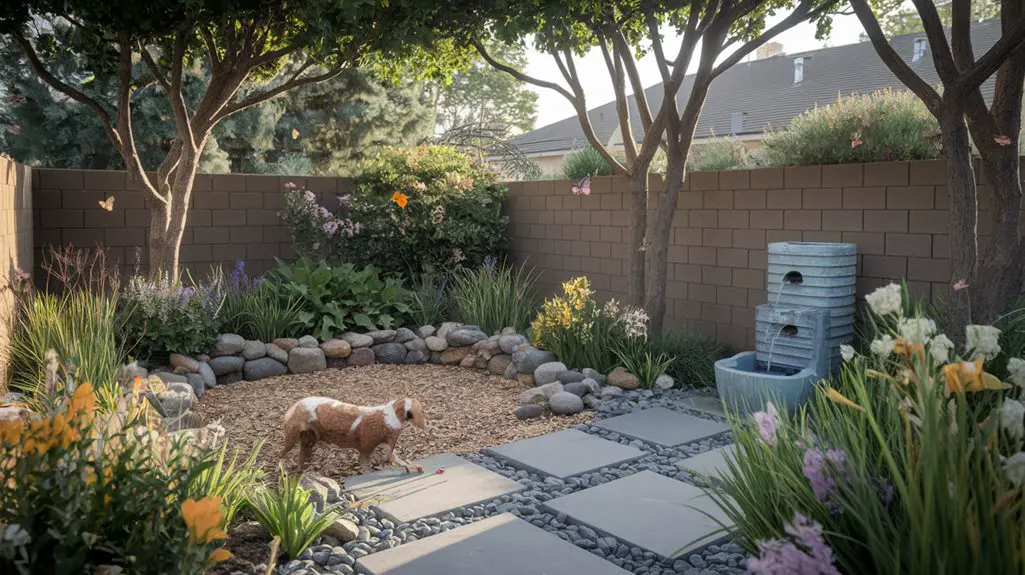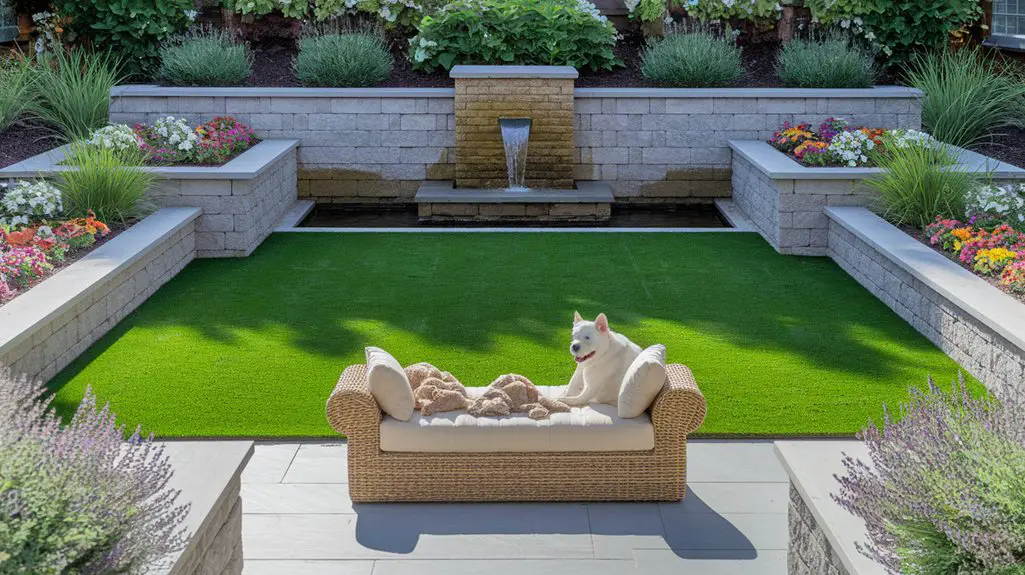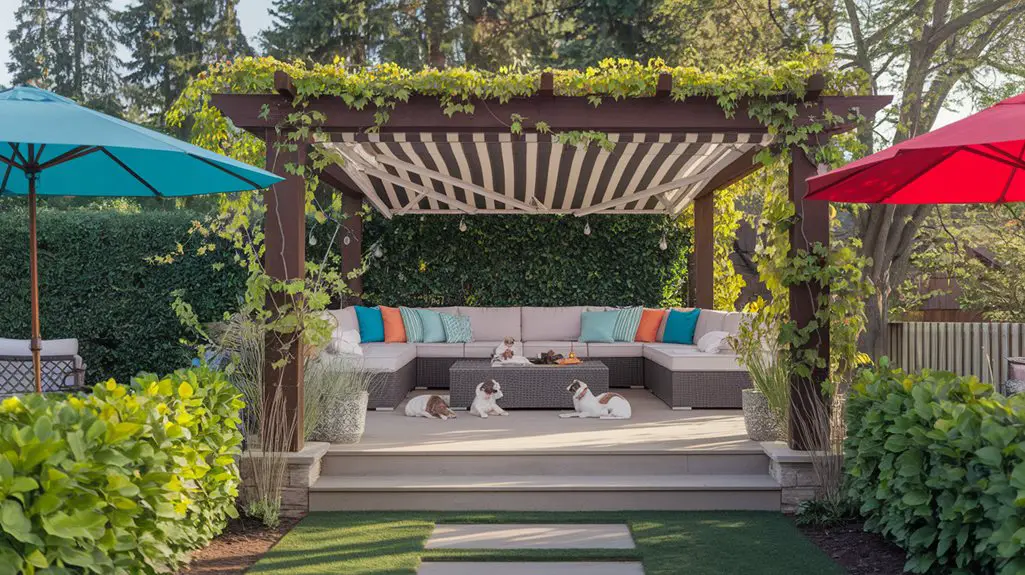Creating a green backyard that welcomes both your pets and sustainable practices doesn’t require sacrificing one for the other. You’ll find that eco-friendly designs can enhance your pet’s quality of life while reducing your environmental footprint. From toxin-free plant selections to water conservation systems that keep your furry friends safely hydrated, each thoughtful modification serves multiple purposes in your outdoor sanctuary. The following tips will transform your ordinary yard into an environmental haven where pets can thrive naturally.
Choose Native Plants That Are Safe for Pets
When designing a pet-friendly backyard, selecting native plants that pose no toxicity risk to your animals becomes a critical first consideration.
Research your regional native species that aren’t harmful to dogs and cats, such as echinacea, asters, and sunflowers. These plants have adapted to local conditions, requiring less water and maintenance than exotic varieties. Additionally, incorporating wildlife habitats with native plants can enhance biodiversity and create a thriving ecosystem in your yard.
Before purchasing any plant, verify its safety through the ASPCA’s toxic plant database. Avoid common toxic species like lilies, azaleas, and foxglove that can cause severe reactions if ingested by pets.
Group safe plants together in designated zones, creating clear boundaries with pet-resistant barriers like stone edging.
Consider raising vulnerable plants in elevated beds to prevent damage from digging or territorial marking. This strategic approach guarantees your yard remains both environmentally sustainable and safe for your four-legged companions.
Create Organic Pet Play Areas With Natural Materials

While designing your backyard ecosystem, establishing dedicated play zones using sustainable materials provides pets with stimulating environments that won’t harm the planet.
Consider installing a natural digging pit filled with coconut coir or untreated wood chips rather than chemical-laden mulch. Border the area with reclaimed stone or fallen timber to create clear boundaries.
For climbing structures, incorporate cedar logs or repurposed bamboo poles—both naturally weather-resistant without chemical treatments. Replace plastic toys with hemp rope for tug games, attach hanging natural fiber ropes to tree branches, or create tunnels from sustainably harvested willow branches.
Integrate pet-safe water features using circulating pumps powered by small solar panels. These provide drinking opportunities and sensory enrichment.
For shaded rest areas, plant tall grasses or install pergolas with climbing edible vines that offer both shelter and occasional treats. Additionally, using natural materials in your landscaping ensures a safer environment for both pets and local wildlife.
Install a Rain Barrel for Pet-Friendly Water Conservation

Three essential benefits make rain barrels a cornerstone of an eco-friendly pet landscape: water conservation, chemical avoidance, and cost savings.
By collecting roof runoff, you’ll reduce municipal water usage while providing untreated water for your lawn—creating safer surfaces for pet paws that haven’t been exposed to chlorine or fluoride. Additionally, utilizing rainwater systems can help promote sustainable practices in your backyard, benefiting both pets and the environment.
Choose a food-grade barrel with a tight-fitting lid to prevent pet access and mosquito breeding.
Install a first-flush diverter to eliminate initial runoff contaminants, ensuring cleaner water.
Position the barrel on a stable, elevated platform (12-24 inches high) to increase water pressure and accommodate watering cans underneath.
Connect multiple barrels in series for increased capacity.
Design Toxin-Free Lawn Alternatives for Paw Traffic
Traditional lawns often require chemical fertilizers, herbicides, and pesticides that pose significant health risks to pets, including skin irritation, digestive distress, and long-term toxic exposure. Consider implementing these safer alternatives that withstand active paw traffic while eliminating toxins from your backyard ecosystem. Additionally, incorporating low-maintenance pet-friendly yard solutions can further enhance the safety and enjoyment of your outdoor space for both pets and their owners.
| Ground Cover | Traffic Tolerance | Benefits |
|---|---|---|
| Clover | High | Nitrogen-fixing, drought-resistant |
| Buffalo grass | Very high | Low maintenance, native species |
| Moss | Low-medium | Thrives in shade, soft texture |
| Thyme | Medium | Aromatic, bee-friendly |
| Synthetic turf | Maximum | Zero chemicals, drainage options |
Select materials based on your climate zone, sun exposure, and your pet’s activity level. Install proper drainage beneath any ground cover to prevent mud formation. Consider creating designated pathways with flagstones or mulch for high-traffic routes your pet frequently uses.
Build Sustainable Pet Waste Management Systems
Proper management of pet waste represents a critical component of an eco-friendly backyard, as untreated animal feces can contaminate soil, waterways, and groundwater with harmful pathogens and excess nutrients.
You’ll need to implement a sustainable disposal system that minimizes environmental impact while maintaining yard hygiene.
Consider installing a pet waste digester—essentially an in-ground miniature septic system that uses enzymatic action to break down waste.
Alternatively, establish a composting system specifically designed for pet waste, incorporating carbon-rich materials like sawdust to facilitate decomposition. These systems must reach temperatures above 140°F to kill pathogens.
For collection, use biodegradable bags rather than plastic ones, and never add pet waste to regular garden compost that’s intended for food production.
Regular waste removal prevents nitrogen buildup that can damage your lawn and plantings. Additionally, maintaining a healthy ecosystem in your backyard can support natural decomposition processes, enhancing the effectiveness of your waste management system.
Incorporate Solar-Powered Pet Features
Incorporating solar energy for pet-focused backyard elements represents a natural extension of your eco-friendly waste management practices.
Consider installing solar-powered water fountains that provide continuous fresh water without increasing utility costs. These systems filter water naturally while encouraging your pets to stay hydrated.
Invest in solar-powered LED lighting along pet pathways to eliminate nighttime accidents and improve visibility during evening bathroom breaks.
Solar motion sensors can also alert you to your pet’s outdoor movements while conserving energy.
For temperature regulation, explore solar-powered pet houses with built-in fans or heating elements that activate automatically based on ambient conditions.
These climate-controlled spaces guarantee your pet’s comfort year-round without drawing from the grid.
Many modern units include backup batteries that store excess solar energy for use during cloudy periods.
Additionally, consider adding creative lighting ideas to enhance your pet’s outdoor experience and create a more inviting atmosphere for both you and your furry friends.
Establish Pet-Safe Garden Boundaries With Recycled Materials
Creating distinct boundaries in your garden serves dual purposes: protecting your plants from curious pets while ensuring your animals don’t encounter toxic vegetation. Repurposing materials not only benefits the environment but provides cost-effective solutions for garden delineation.
- Transform discarded wooden pallets into vertical barriers by disassembling, sanding rough edges, and arranging in zigzag patterns to create visually appealing pet deterrents.
- Utilize reclaimed brick or stone to construct low-height borders that physically separate garden zones without restricting your pet’s visibility.
- Convert old bamboo blinds into rolled garden edging that’s flexible enough to curve around irregular beds yet sturdy enough to withstand playful pets.
- Repurpose glass bottles by partially burying them upside-down to create colorful, weather-resistant boundaries that reflect sunlight. Additionally, using recycled materials for your garden boundaries can significantly reduce waste and promote sustainability.
Plant a Pet-Friendly Herb and Vegetable Garden
While designing your outdoor space, consider that an herb and vegetable garden can provide dual benefits for both you and your pets when properly planned.
Select pet-safe edibles such as carrots, blueberries, green beans, and pumpkin, which offer nutritional value for both species.
Dedicate a section to pet-friendly herbs including parsley, basil, and mint—plants that are safe for animals to nibble and can aid in digestion.
Install raised beds using untreated cedar or recycled plastic lumber to prevent pets from accessing potentially harmful soil amendments.
For additional protection, incorporate companion planting techniques: marigolds naturally repel insects without chemical pesticides, while catnip or cat grass provides designated areas for felines to enjoy.
Always verify plant safety through veterinary resources before introducing new species into your shared garden environment. Additionally, consider utilizing companion planting techniques to enhance the health and productivity of your garden while keeping it safe for your pets.
Create Shaded Retreats Using Living Structures
Both pets and humans benefit from natural shade in outdoor spaces, especially during hot summer months when sun exposure can lead to heat-related illnesses.
Living structures provide sustainable, eco-friendly alternatives to artificial shade solutions while enhancing your yard’s biodiversity.
- Train climbing vines like clematis or jasmine on strategically positioned trellises to create cooling shade corridors that allow pets to traverse the yard without excessive sun exposure.
- Install living willow domes or tunnels that serve as both architectural features and cozy retreats where pets can escape midday heat.
- Plant fast-growing bamboo clusters in contained areas to create dense shade pockets that reduce ground temperature by up to 10°F.
- Position large ornamental grasses in western exposures to filter afternoon sun while providing pets with natural hiding spots and sensory stimulation.
Additionally, incorporating non-toxic pest control techniques within your living structures can help keep your outdoor space safe and enjoyable for both pets and humans.
Develop Water-Efficient Splash Zones for Hot Days
Pets need reliable access to cooling water features during warm weather, yet traditional splash zones often waste significant amounts of this precious resource.
Implement recirculating water systems that filter and reuse water through a small pump mechanism, reducing consumption by up to 80% compared to continuous-flow options.
Install shallow basins with gently sloped sides for safety, using natural filtration materials like river rocks and aquatic plants to maintain water quality between changes.
Consider motion-activated sprinklers that operate only when your pet approaches, or water-efficient misting systems that cool without creating standing water.
Collect rainwater in a sealed barrel system fitted with a UV filter to supply your pet’s splash zone, keeping water fresh while lowering your environmental footprint. DIY rainwater collection ideas can help you optimize your water use even further.
Remember to empty and clean all water features regularly to prevent mosquito breeding.
Conclusion
Your pet-friendly paradise needn’t compromise conservation commitments. By implementing these ten techniques, you’ve transformed your traditional terrain into an eco-efficient ecosystem where pets play purposefully while preserving precious planetary resources. You’re now maintaining a meticulously managed microhabitat that merges multiple benefits: reduced resource consumption, decreased chemical dependency, and enhanced environmental equilibrium. Your backyard’s biodiversity bolsters both wildlife welfare and your pet’s perpetual pleasure in their sustainable sanctuary.



